The following sections enumerate the myriad of field mappings EJB persistence supports. EJB augments the persistence metadata covered in Chapter 5, Metadata with many new object-relational annotations. As we explore the library of standard mappings, we introduce each of these enhancements in context.
![[Note]](img/note.gif) | Note |
|---|---|
Kodo supports many additional field types, and allows you to create custom mappings for unsupported field types or database schemas. See the Reference Guide's Chapter 7, Mapping for complete coverage of Kodo EJB's mapping capabilities. |
A basic field mapping stores the field value directly into a database column. The following field metadata types use basic mapping. These types were defined in Section 5.2, “Field and Property Metadata”.
In fact, you have already seen examples of basic field mappings in
this chapter - the mapping of all identity fields in
Example 12.3, “Identity Mapping”. As you saw
in that section, to write a basic field mapping you use the
Column annotation to describe the column
the field value is stored in. We discussed the Column
annotation in
Section 12.3, “Column”. Recall that the
name of the column defaults to the field name, and the type of the
column defaults to an appropriate type for the field type.
These defaults allow you to sometimes omit the annotation
altogether.
Adding the Lob marker annotation to a
basic field signals that the data is to be stored as a
LOB (Large OBject). If the field holds string
or character data, it will map to a CLOB
(Character Large OBject) database column. If the field holds
any other data type, it will be stored as binary data in a
BLOB (Binary Large OBject) column. The
implementation will serialize the Java value if needed.
The equivalent XML element is lob,
which has no children or attributes.
You can apply the Enumerated annotation
to your Enum fields to control how they
map to the database. The Enumerated
annotation's value one of the following constants from the
EnumType enum:
EnumType.ORDINAL: The default. The persistence implementation places the ordinal value of the enum in a numeric column. This is an efficient mapping, but may break if you rearrange the Java enum declaration.EnumType.STRING: Store the name of the enum value rather than the ordinal. This mapping uses aVARCHARcolumn rather than a numeric one.
The Enumerated annotation is
optional. Any un-annotated enumeration field defaults to
ORDINAL mapping.
The corresponding XML element is enumerated.
Its embedded text must be one of
STRING or ORIDINAL.
The Temporal annotation determines
how the implementation handles your basic
java.util.Date and
java.util.Calendar fields at the JDBC level. The
Temporal annotation's value is a
constant from the TemporalType enum.
Available values are:
TemporalType.TIMESTAMP: The default. Use JDBC's timestamp APIs to manipulate the column data.TemporalType.DATE: Use JDBC's SQL date APIs to manipulate the column data.TemporalType.TIME: Use JDBC's time APIs to manipulate the column data.
If the Temporal annotation is omitted,
the implementation will treat the data as a timestamp.
The corresponding XML element is temporal,
whose text value must be one of:
TIME, DATE, or
TIMESTAMP.
Below we present an updated diagram of our model and its
associated database schema, followed by the corresponding
mapping metadata. Note that the mapping metadata relies on
defaults where possible. Also note that as a mapped superclass,
Document can define mappings that will
automatically transfer to its subclass' tables. In
Section 12.8.3, “Embedded Mapping”, you will see how
a subclass can override its mapped superclass' mappings.
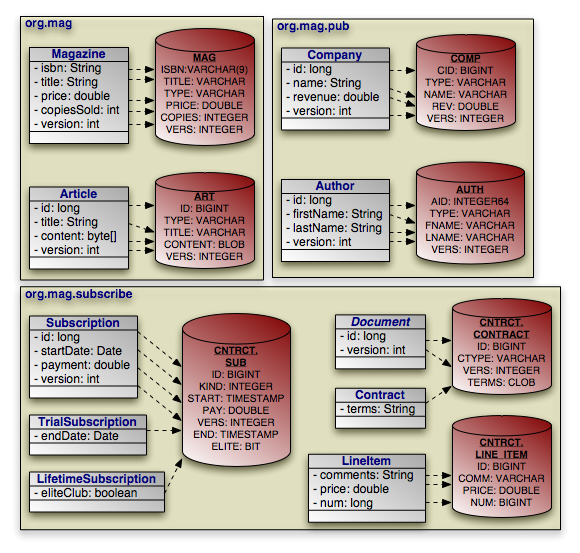
Example 12.10. Basic Field Mapping
package org.mag;
@Entity
@IdClass(Magazine.MagazineId.class)
@Table(name="MAG")
@DiscriminatorValue("Mag")
public class Magazine
{
@Column(length=9)
@Id private String isbn;
@Id private String title;
@Column(name="VERS")
@Version private int version;
private String name;
private double price;
@Column(name="COPIES")
private int copiesSold;
...
public static class MagazineId
{
...
}
}
@Entity
@Table(name="ART", uniqueConstraints=@Unique(columnNames="TITLE"))
@SequenceGenerator(name="ArticleSeq", sequenceName="ART_SEQ")
public class Article
{
@Id
@GeneratedValue(strategy=GenerationType.SEQUENCE, generator="ArticleSeq")
private long id;
@Column(name="VERS")
@Version private int version;
private String title;
private byte[] content;
...
}
package org.mag.pub;
@Entity
@Table(name="COMP")
public class Company
{
@Column(name="CID")
@Id private long id;
@Column(name="VERS")
@Version private int version;
private String name;
@Column(name="REV")
private double revenue;
...
}
@Entity
@Table(name="AUTH")
public class Author
{
@Id
@GeneratedValue(strategy=GenerationType.TABLE, generator="AuthorGen")
@TableGenerator(name="AuthorGen", table="AUTH_GEN", pkColumnName="PK",
valueColumnName="AID")
@Column(name="AID", columnDefinition="INTEGER64")
private long id;
@Column(name="VERS")
@Version private int version;
@Column(name="FNAME")
private String firstName;
@Column(name="LNAME")
private String lastName;
...
}
@Embeddable
public class Address
{
...
}
package org.mag.subscribe;
@MappedSuperclass
public abstract class Document
{
@Id
@GeneratedValue(strategy=GenerationType.IDENTITY)
private long id;
@Column(name="VERS")
@Version private int version;
...
}
@Entity
@Table(schema="CNTRCT")
@Inheritance(strategy=InheritanceType.JOINED)
@DiscriminatorColumn(name="CTYPE")
public class Contract
extends Document
{
@Lob
private String terms;
...
}
@Entity
@Table(name="SUB", schema="CNTRCT")
@DiscriminatorColumn(name="KIND", discriminatorType=DiscriminatorType.INTEGER)
@DiscriminatorValue("1")
public class Subscription
{
@Id
@GeneratedValue(strategy=GenerationType.IDENTITY)
private long id;
@Column(name="VERS")
@Version private int version;
@Column(name="START")
private Date startDate;
@Column(name="PAY")
private double payment;
...
@Entity
@Table(name="LINE_ITEM", schema="CNTRCT")
public static class LineItem
extends Contract
{
@Column(name="COMM")
private String comments;
private double price;
private long num;
...
}
}
@Entity(name="Lifetime")
@DiscriminatorValue("2")
public class LifetimeSubscription
extends Subscription
{
@Basic(fetch=FetchType.LAZY)
@Column(name="ELITE")
private boolean getEliteClub () { ... }
public void setEliteClub (boolean elite) { ... }
...
}
@Entity(name="Trial")
@DiscriminatorValue("3")
public class TrialSubscription
extends Subscription
{
@Column(name="END")
public Date getEndDate () { ... }
public void setEndDate (Date end) { ... }
...
}
The same metadata expressed in XML:
<entity-mappings xmlns="http://java.sun.com/xml/ns/persistence/orm"
xmlns:xsi="http://www.w3.org/2001/XMLSchema-instance"
xsi:schemaLocation="http://java.sun.com/xml/ns/persistence/orm orm_1_0.xsd"
version="1.0">
<mapped-superclass class="org.mag.subscribe.Document">
<attributes>
<id name="id">
<generated-value strategy="IDENTITY"/>
</id>
<version name="version">
<column name="VERS"/>
</version>
...
</attributes>
</mapped-superclass>
<entity class="org.mag.Magazine">
<table name="MAG"/>
<id-class="org.mag.Magazine.MagazineId"/>
<discriminator-value>Mag</discriminator-value>
<attributes>
<id name="isbn">
<column length="9"/>
</id>
<id name="title"/>
<basic name="name"/>
<basic name="price"/>
<basic name="copiesSold">
<column name="COPIES"/>
</basic>
<version name="version">
<column name="VERS"/>
</version>
...
</attributes>
</entity>
<entity class="org.mag.Article">
<table name="ART">
<unique-constraint>
<column-name>TITLE</column-name>
</unique-constraint>
</table>
<sequence-generator name="ArticleSeq", sequenceName="ART_SEQ"/>
<attributes>
<id name="id">
<generated-value strategy="SEQUENCE" generator="ArticleSeq"/>
</id>
<basic name="title"/>
<basic name="content"/>
<version name="version">
<column name="VERS"/>
</version>
...
</attributes>
</entity>
<entity class="org.mag.pub.Company">
<table name="COMP"/>
<attributes>
<id name="id">
<column name="CID"/>
</id>
<basic name="name"/>
<basic name="revenue">
<column name="REV"/>
</basic>
</attributes>
</entity>
<entity class="org.mag.pub.Author">
<table name="AUTH"/>
<attributes>
<id name="id">
<column name="AID" column-definition="INTEGER64"/>
<generated-value strategy="TABLE" generator="AuthorGen"/>
<table-generator name="AuthorGen" table="AUTH_GEN"
pk-column-name="PK" value-column-name="AID"/>
</id>
<basic name="firstName">
<column name="FNAME"/>
</basic>
<basic name="lastName">
<column name="LNAME"/>
</basic>
<version name="version">
<column name="VERS"/>
</version>
...
</attributes>
</entity>
<entity class="org.mag.subcribe.Contract">
<table schema="CNTRCT"/>
<inheritance strategy="JOINED"/>
<discriminator-column name="CTYPE"/>
<attributes>
<basic name="terms">
<lob/>
</basic>
...
</attributes>
</entity>
<entity class="org.mag.subcribe.Subscription">
<table name="SUB" schema="CNTRCT"/>
<inheritance strategy="SINGLE_TABLE"/>
<discriminator-value>1</discriminator-value>
<discriminator-column name="KIND" discriminator-type="INTEGER"/>
<attributes>
<id name="id">
<generated-value strategy="IDENTITY"/>
</id>
<basic name="payment">
<column name="PAY"/>
</basic>
<basic name="startDate">
<column name="START"/>
</basic>
<version name="version">
<column name="VERS"/>
</version>
...
</attributes>
</entity>
<entity class="org.mag.subscribe.Subscription.LineItem">
<table name="LINE_ITEM" schema="CNTRCT"/>
<primary-key-join-column name="ID" referenced-column-name="PK"/>
<attributes>
<basic name="comments">
<column name="COMM"/>
</basic>
<basic name="price"/>
<basic name="num"/>
...
</attributes>
</entity>
<entity class="org.mag.subscribe.LifetimeSubscription" name="Lifetime">
<discriminator-value>2</discriminator-value>
<attributes>
<basic name="eliteClub" fetch="LAZY">
<column name="ELITE"/>
</basic>
...
</attributes>
</entity>
<entity class="org.mag.subscribe.TrialSubscription" name="Trial">
<discriminator-value>3</discriminator-value>
<attributes>
<basic name="endDate">
<column name="END"/>
</basic>
...
</attributes>
</entity>
</entity-mappings>
Sometimes a a logical record is spread over multiple database tables. EJB persistence calls a class' declared table the primary table, and calls other tables that make up a logical record secondary tables. You can map any persistent field to a secondary table. Just write the standard field mapping, then perform these two additional steps:
Set the
tableattribute of each of the field's columns or join columns to the name of the secondary table.Define the secondary table on the entity class declaration.
You define secondary tables with the SecondaryTable
annotation. This annotation has all the properties
of the Table annotation covered in
Section 12.1, “Table”, plus a
pkJoinColumns property.
The pkJoinColumns property is an array of
PrimaryKeyJoinColumns dictating how to join
secondary table records to their owning primary table records. Each
PrimaryKeyJoinColumn joins a secondary table
column to a primary key column in the primary table. See
Section 12.6.2, “Joined” above for
coverage of PrimaryKeyJoinColumn's
properties.
The corresponding XML element
is secondary-table. This element has all
the attributes of the table element, but also
accepts nested primary-key-join-column elements.
In the following example, we move the Article.content
field we mapped in
Section 12.8.1, “Basic Mapping” into a joined
secondary table, like so:
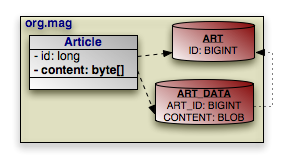
Example 12.11. Secondary Table Field Mapping
package org.mag;
@Entity
@Table(name="ART")
@SecondaryTable(name="ART_DATA",
pkJoinColumns=@PrimaryKeyJoinColumn(name="ART_ID", referencedColumnName="ID"))
public class Article
{
@Id private long id;
@Column(table="ART_DATA")
private byte[] content;
...
}
And in XML:
<entity class="org.mag.Article">
<table name="ART">
<secondary-table name="ART_DATA">
<primary-key-join-column name="ART_ID" referenced-column-name="ID"/>
</secondary-table>
<attributes>
<id name="id"/>
<basic name="content">
<column table="ART_DATA"/>
</basic>
...
</attributes>
</entity>
Chapter 5, Metadata describes EJB's concept of embeddable objects. The field values of embedded objects are stored as part of the owning record, rather than as a separate database record. Thus, instead of mapping a relation to an embeddable object as a foreign key, you map all the fields of the embeddable instance to columns in the owning field's table.
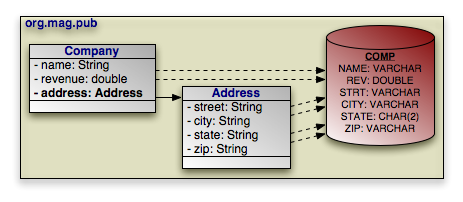
EJB persistence defaults the embedded column names and descriptions
to those of the embeddable class' field mappings. The
AttributeOverride annotation overrides a basic embedded
mapping. This annotation has the following properties:
String name: The name of the embedded class' field being mapped to this class' table.Column column: The column defining the mapping of the embedded class' field to this class' table.
The corresponding XML element is
attribute-override. It has a single name
attribute to name the field being overridden,
and a single column child element.
To declare multiple overrides, use the AttributeOverrides
annotation, whose value is an array of
AttributeOverrides. In XML, simply list
multiple attribute-override elements in
succession.
To override a many to one or one to one relationship, use the
AssociationOverride annotation in place of
AttributeOverride.
AssociationOverride has the following properties:
String name: The name of the embedded class' field being mapped to this class' table.JoinColumn[] joinColumns: The foreign key columns joining to the related record.
The corresponding XML element is
association-override. It has a single name
attribute to name the field being overridden,
and one or more join-column child elements.
To declare multiple relation overrides, use the
AssociationOverrides annotation, whose value is an
array of AssociationOverrides. In XML,
simply list multiple association-override
elements in succession.
Example 12.12. Embedded Field Mapping
In this example, Company overrides the
default mapping of Address.street and
Address.city.
All other embedded mappings are taken from the
Address embeddable class.
package org.mag.pub;
@Entity
@Table(name="COMP")
public class Company
{
@Embedded
@AttributeOverrides({
@AttributeOverride(name="street", column=@Column(name="STRT")),
@AttributeOverride(name="city", column=@Column(name="ACITY"))
})
private Address address;
...
}
@Entity
@Table(name="AUTH")
public class Author
{
// use all defaults from Address class mappings
private Address address;
...
}
@Embeddable
public class Address
{
private String street;
private String city;
@Column(columnDefinition="CHAR(2)")
private String state;
private String zip;
}
The same metadata expressed in XML:
<entity class="org.mag.pub.Company">
<table name="COMP"/>
<attributes>
...
<embedded name="address">
<attribute-override name="street">
<column name="STRT"/>
</attribute-override>
<attribute-override name="city">
<column name="ACITY"/>
</attribute-override>
</embedded>
</attributes>
</entity>
<entity class="org.mag.pub.Author">
<table name="AUTH"/>
<attributes>
<embedded name="address">
<!-- use all defaults from Address -->
</embedded>
</attributes>
</entity>
<embeddable class="org.mag.pub.Address">
<attributes>
<basic name="street"/>
<basic name="city"/>
<basic name="state">
<column column-definition="CHAR(2)"/>
</basic>
<basic name="zip"/>
</attributes>
</embeddable>
You can also use attribute overrides on an entity class to
override mappings defined by
its mapped superclass or table-per-class superclass. The example
below re-maps the Document.version field to the
Contract table's CVERSION
column.
Example 12.13. Mapping Mapped Superclass Field
@MappedSuperclass
public abstract class Document
{
@Column(name="VERS")
@Version private int version;
...
}
@Entity
@Table(schema="CNTRCT")
@Inheritance(strategy=InheritanceType.JOINED)
@DiscriminatorColumn(name="CTYPE")
@AttributeOverride(name="version", column=@Column(name="CVERSION"))
public class Contract
extends Document
{
...
}
The same metadata expressed in XML form:
<mapped-superclass class="org.mag.subcribe.Document">
<attributes>
<version name="version">
<column name="VERS">
</version>
...
</attributes>
</mapped-superclass>
<entity class="org.mag.subcribe.Contract">
<table schema="CNTRCT"/>
<inheritance strategy="JOINED"/>
<discriminator-column name="CTYPE"/>
<attribute-override name="version">
<column name="CVERSION"/>
</attribute-override>
<attributes>
...
</attributes>
</entity>
A direct relation is a non-embedded persistent field that holds a
reference to another entity.
many to one and
one to one
metadata field types are mapped as direct
relations. Our model has three direct relations:
Magazine's publisher
field is a direct relation to a Company,
Magazine's coverArticle
field is a direct relation to Article, and
the LineItem.magazine field is a direct relation
to a Magazine. Direct relations are
represented in the database by foreign key columns:
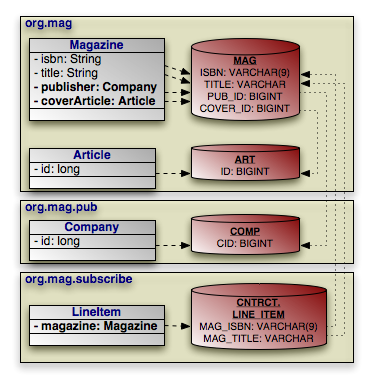
You typically map a direct relation with
JoinColumn annotations describing how the
local foreign key columns join to the primary key columns of the
related record. The JoinColumn annotation
exposes the following properties:
String name: The name of the foreign key column. Defaults to the relation field name, plus an underscore, plus the name of the referenced primary key column.String referencedColumnName: The name of the primary key column being joined to. If there is only one identity field in the related entity class, the join column name defaults to the name of the identity field's column.boolean unique: Whether this column is guaranteed to hold unique values for all rows. Defaults to false.
JoinColumn also has the same
nullable, insertable,
updatable, columnDefinition, and
table properties as the
Column annotation. See
Section 12.3, “Column” for details on these
properties.
The join-column element represents a join column
in XML. Its attributes mirror the above annotation's properties:
namereferenced-column-nameuniquenullableinsertableupdatablecolumn-definitiontable
When there are multiple columns involved in the join, as when a
LineItem references a Magazine
in our model, the JoinColumns
annotation allows you to specify an array of JoinColumn
values. In XML, simply list multiple
join-column elements.
![[Note]](img/note.gif) | Note |
|---|---|
Kodo supports many non-standard joins. See Section 7.6, “Non-Standard Joins” in the Reference Guide for details. |
Example 12.14. Direct Relation Field Mapping
package org.mag;
@Table(name="AUTH")
public class Magazine
{
@Column(length=9)
@Id private String isbn;
@Id private String title;
@OneToOne
@JoinColumn(name="COVER_ID" referencedColumnName="ID")
private Article coverArticle;
@ManyToOne
@JoinColumn(name="PUB_ID" referencedColumnName="CID")
private Company publisher;
...
}
@Table(name="ART")
public class Article
{
@Id private long id;
...
}
package org.mag.pub;
@Table(name="COMP")
public class Company
{
@Column(name="CID")
@Id private long id;
...
}
package org.mag.subscribe;
public class Subscription
{
...
@Table(name="LINE_ITEM", schema="CNTRCT")
public static class LineItem
extends Contract
{
@ManyToOne
@JoinColumns({
@JoinColumn(name="MAG_ISBN" referencedColumnName="ISBN"),
@JoinColumn(name="MAG_TITLE" referencedColumnName="TITLE")
})
private Magazine magazine;
...
}
}
The same metadata expressed in XML form:
<entity class="org.mag.Magazine">
<table name="MAG"/>
<id-class="org.mag.Magazine.MagazineId"/>
<attributes>
<id name="isbn">
<column length="9"/>
</id>
<id name="title"/>
<one-to-one name="coverArticle">
<join-column name="COVER_ID" referenced-column-name="ID"/>
</one-to-one>
<many-to-one name="publisher">
<join-column name="PUB_IC" referenced-column-name="CID"/>
</many-to-one>
...
</attributes>
</entity>
<entity class="org.mag.Article">
<table name="ART"/>
<attributes>
<id name="id"/>
...
</attributes>
</entity>
<entity class="org.mag.pub.Company">
<table name="COMP"/>
<attributes>
<id name="id">
<column name="CID"/>
</id>
...
</attributes>
</entity>
<entity class="org.mag.subscribe.Subscription.LineItem">
<table name="LINE_ITEM" schema="CNTRCT"/>
<primary-key-join-column name="ID" referenced-column-name="PK"/>
<attributes>
<many-to-one name="magazine">
<join-column name="MAG_ISBN" referenced-column-name="ISBN"/>
<join-column name="MAG_TITLE" referenced-column-name="TITLE"/>
</many-to-one>
...
</attributes>
</entity>
When the entities in a one to one relation join on
shared primary key values rather than separate foreign key columns,
use the PrimaryKeyJoinColumn(s)
annotation or primary-key-join-column elements
in place of JoinColumn(s) /
join-column elements.
A join table consists of two foreign keys. Each row of a join table associates two objects together. EJB persistence uses join tables to represent collections of entity objects: one foreign key refers back to the collection's owner, and the other refers to a collection element.
one to many and
many to many
metadata field types can map to join
tables. Several fields in our model use join table mappings,
including Magazine.articles and
Article.authors.
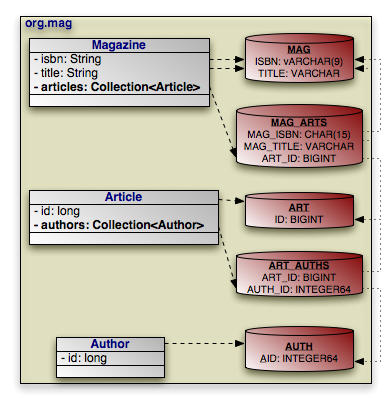
You define join tables with the JoinTable
annotation. This annotation has the following properties:
String name: Table name. If not given, the name of the table defaults to the name of the owning entity's table, plus an underscore, plus the name of the related entity's table.String catalog: Table catalog.String schema: Table schema.JoinColumn[] joinColumns: Array ofJoinColumnsshowing how to associate join table records with the owning row in the primary table. This property mirrors thepkJoinColumnsproperty of theSecondaryTableannotation in functionality. See Section 12.8.2, “Secondary Tables” to refresh your memory on secondary tables.If this is a bidirectional relation (see Section 5.2.9.1, “Bidirectional Relations”), the name of a join column defaults to the inverse field name, plus an underscore, plus the referenced primary key column name. Otherwise, the join column name defaults to the field's owning entity name, plus an underscore, plus the referenced primary key column name.
JoinColumn[] inverseJoinColumns: Array ofJoinColumnsshowing how to associate join table records with the records that form the elements of the collection. These join columns are used just like the join columns for direct relations, and they have the same naming defaults. Read Section 12.8.4, “Direct Relations” for a review of direct relation mapping.
join-table is the corresponding XML element.
It has the same attributes as the table
element, but includes the ability to nest
join-column and
inverse-join-column elements as children.
We have seen join-column elements already;
inverse-join-column elements have the same
attributes.
Here are the join table mappings for the diagram above.
Example 12.15. Join Table Mapping
package org.mag;
@Entity
@Table(name="MAG")
public class Magazine
{
@Column(length=9)
@Id private String isbn;
@Id private String title;
@OneToMany(...)
@OrderBy
@JoinTable(name="MAG_ARTS",
joinColumns={
@JoinColumn(name="MAG_ISBN", referencedColumnName="ISBN"),
@JoinColumn(name="MAG_TITLE", referencedColumnName="TITLE")
},
inverseJoinColumns=@JoinColumn(name="ART_ID", referencedColumnName="ID"))
private Collection<Article> articles;
...
}
@Entity
@Table(name="ART")
public class Article
{
@Id private long id;
@ManyToMany(cascade=CascadeType.PERSIST)
@OrderBy("lastName, firstName")
@JoinTable(name="ART_AUTHS",
joinColumns=@JoinColumn(name="ART_ID", referencedColumnName="ID"),
inverseJoinColumns=@JoinColumn(name="AUTH_ID", referencedColumnName="AID"))
private Collection<Author> authors;
...
}
package org.mag.pub;
@Entity
@Table(name="AUTH")
public class Author
{
@Column(name="AID", columnDefinition="INTEGER64")
@Id private long id;
...
}
The same metadata expressed in XML:
<entity class="org.mag.Magazine">
<table name="MAG"/>
<attributes>
<id name="isbn">
<column length="9"/>
</id>
<id name="title"/>
<one-to-many name="articles">
<order-by/>
<join-table name="MAG_ARTS">
<join-column name="MAG_ISBN" referenced-column-name="ISBN"/>
<join-column name="MAG_TITLE" referenced-column-name="TITLE"/>
</join-table>
</one-to-many>
...
</attributes>
</entity>
<entity class="org.mag.Article">
<table name="ART"/>
<attributes>
<id name="id"/>
<many-to-many name="articles">
<order-by>lastName, firstName</order-by>
<join-table name="ART_AUTHS">
<join-column name="ART_ID" referenced-column-name="ID"/>
<inverse-join-column name="AUTH_ID" referenced-column-name="AID"/>
</join-table>
</many-to-many>
...
</attributes>
</entity>
<entity class="org.mag.pub.Author">
<table name="AUTH"/>
<attributes>
<id name="id">
<column name="AID" column-definition="INTEGER64"/>
</id>
...
</attributes>
</entity>
Section 5.2.9.1, “Bidirectional Relations” introduced
bidirectional relations. To map a bidirectional relation, you map
one field normally using the annotations we have covered throughout
this chapter. Then you use the mappedBy property
of the other field's metadata annotation or the corresponding
mapped-by XML attribute to refer to the mapped
field. Look for this pattern in these bidirectional relations as
you peruse the complete mappings below:
Magazine.publisherandCompany.ags.Article.authorsandAuthor.articles.
All map fields in EJB persistence are modeled on either
one to many or many to many associations. The map key is always
derived from an associated
entity's field. Thus map fields use the same mappings as any
one to many or many to many fields, namely dedicated
join tables
or bidirectional
relations. The only additions are the MapKey
annotation and map-key element to
declare the key field. We covered these additions in
in Section 5.2.13, “Map Key”.
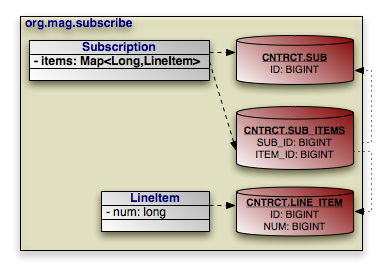
The example below maps Subscription's map of
LineItems to the SUB_ITEMS
join table. The key for each map entry is the
LineItem's num field value.
Example 12.16. Join Table Map Mapping
package org.mag.subscribe;
@Entity
@Table(name="SUB", schema="CNTRCT")
public class Subscription
{
@OneToMany(cascade={CascadeType.PERSIST,CascadeType.REMOVE})
@MapKey(name="num")
@JoinTable(name="SUB_ITEMS", schema="CNTRCT",
joinColumns=@JoinColumn(name="SUB_ID"),
inverseJoinColumns=@JoinColumn(name="ITEM_ID"))
private Map<Long,LineItem> items;
...
@Entity
@Table(name="LINE_ITEM", schema="CNTRCT")
public static class LineItem
extends Contract
{
private long num;
...
}
}
The same metadata expressed in XML:
<entity class="org.mag.subscribe.Subscription">
<table name="SUB" schema="CNTRCT"/>
<attributes>
...
<one-to-many name="items">
<map-key name="num">
<join-table name="MAG_ARTS">
<join-column name="MAG_ISBN" referenced-column-name="ISBN"/>
<join-column name="MAG_TITLE" referenced-column-name="TITLE"/>
</join-table>
<cascade>
<cascade-persist/>
<cascade-remove/>
</cascade>
</one-to-many>
...
</attributes>
</entity>
<entity class="org.mag.subscribe.Subscription.LineItem">
<table name="LINE_ITEM" schema="CNTRCT"/>
<attributes>
...
<basic name="num"/>
...
</attributes>
</entity>